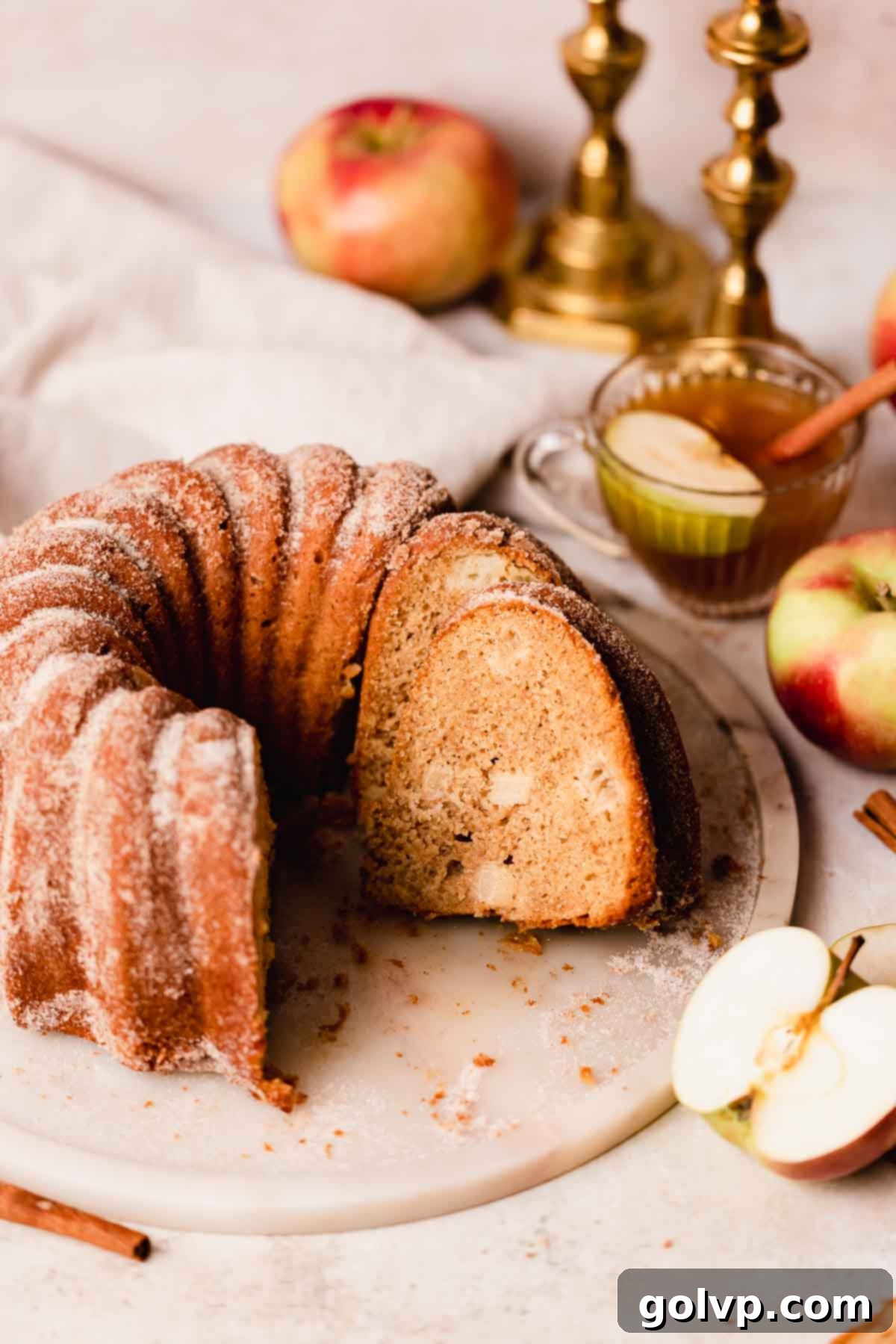The Ultimate Moist Apple Cider Bundt Cake: Your Perfect Fall Dessert
Embrace the cozy flavors of autumn with this incredibly tender, moist, and fluffy Apple Cider Bundt Cake. It’s a true celebration of fall, tasting just like your favorite apple cider donuts, but in an elegant cake form! Each slice is generously coated in a warm brown butter glaze and a classic cinnamon sugar mixture, delivering an irresistible texture and a burst of seasonal flavor that transports you straight to an apple orchard.
What makes this bundt cake stand out? We’ve infused it with triple the apple goodness: rich applesauce, concentrated apple cider, and tender chunks of fresh apple distributed throughout the batter. This thoughtful combination ensures a profound, authentic apple flavor in every bite. To guarantee exceptional moisture and tenderness that lasts for days, a reduced apple cider syrup is lovingly poured over the cake immediately after it emerges from the oven, soaking in and locking in all that deliciousness.
The final touch is a golden-brown butter coating, which not only acts as the perfect adhesive for the sparkling cinnamon sugar but also imparts a delightful, nutty depth that elevates the entire experience. This cake isn’t just a dessert; it’s a comforting, aromatic centerpiece perfect for any fall gathering or a quiet afternoon treat.
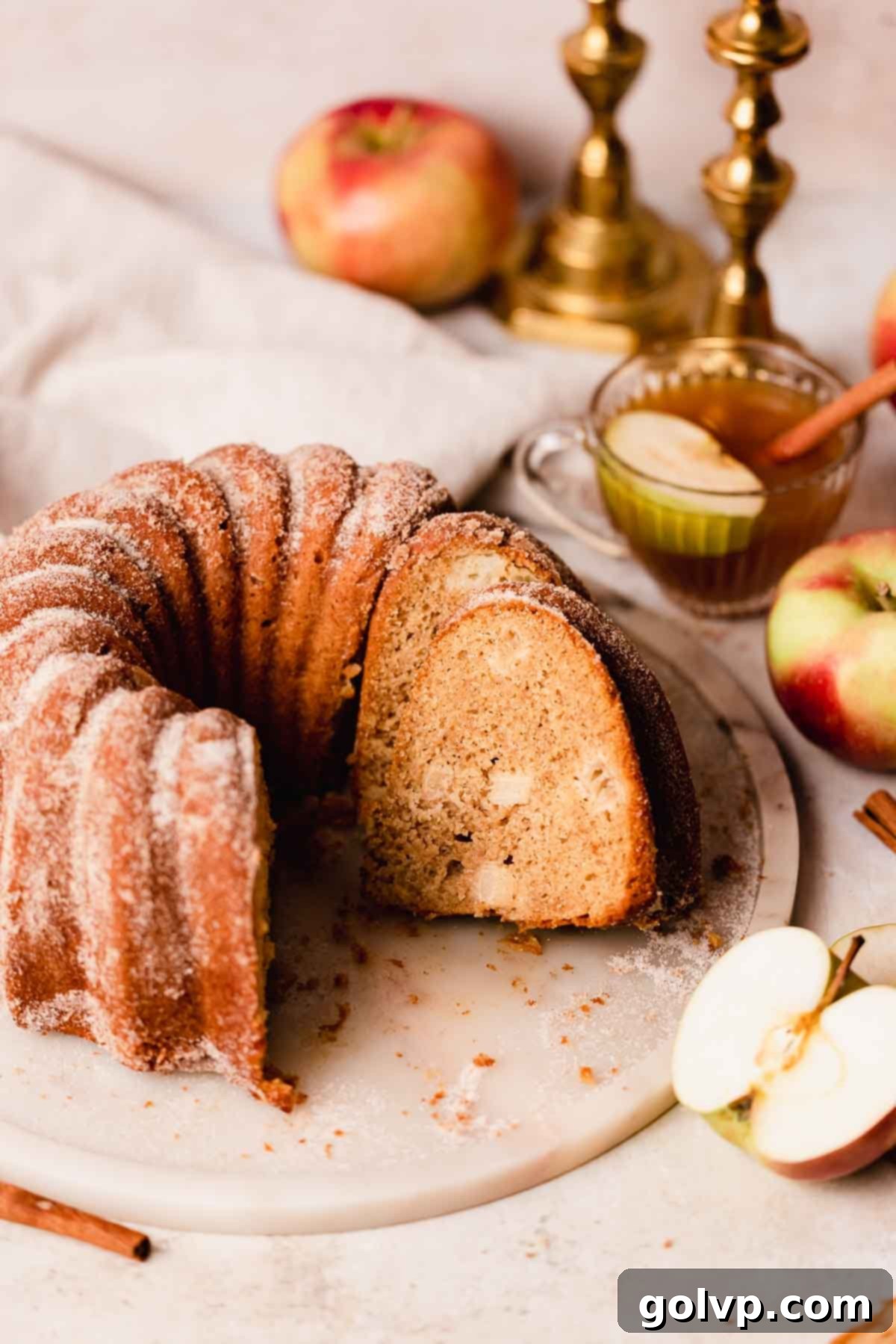
🍎 Why You’ll Love This Apple Cider Bundt Cake Recipe
- Unbeatable Texture: Prepare for a cake that is exceptionally moist, buttery, and incredibly soft. The perfect balance is achieved through the ingenious combination of apple cider, applesauce, a touch of vegetable oil for tenderness, and rich butter for flavor. This ensures a crumb that’s delicate yet substantial, melting in your mouth with every bite.
- The Quintessential Fall Flavor: This isn’t just an apple cake; it’s the taste of autumn personified in a bundt pan. Lightly spiced with warm cinnamon and nutmeg, it evokes the delightful aroma of a crisp fall day and a visit to your favorite apple orchard. The decadent brown butter and cinnamon sugar topping adds a toasty, caramelized note, making it taste uncannily like a gourmet apple cider donut.
- Surprisingly Easy to Make: Don’t let its sophisticated flavor fool you – this bundt cake is remarkably straightforward to prepare. The process involves simple steps: creaming together the butter, sugars, and oil, then gradually incorporating the remaining ingredients. Even beginner bakers can achieve spectacular results with this recipe.
If you’re a connoisseur of bundt cakes, you absolutely must try our Cinnamon Bundt Cake with Gooey Cinnamon Swirl for another delightful treat!

📝 Key Ingredients for Apple Cider Bundt Cake
For ultimate success, pay attention to these essential tips! Full steps and detailed ingredients are available in the recipe card below.
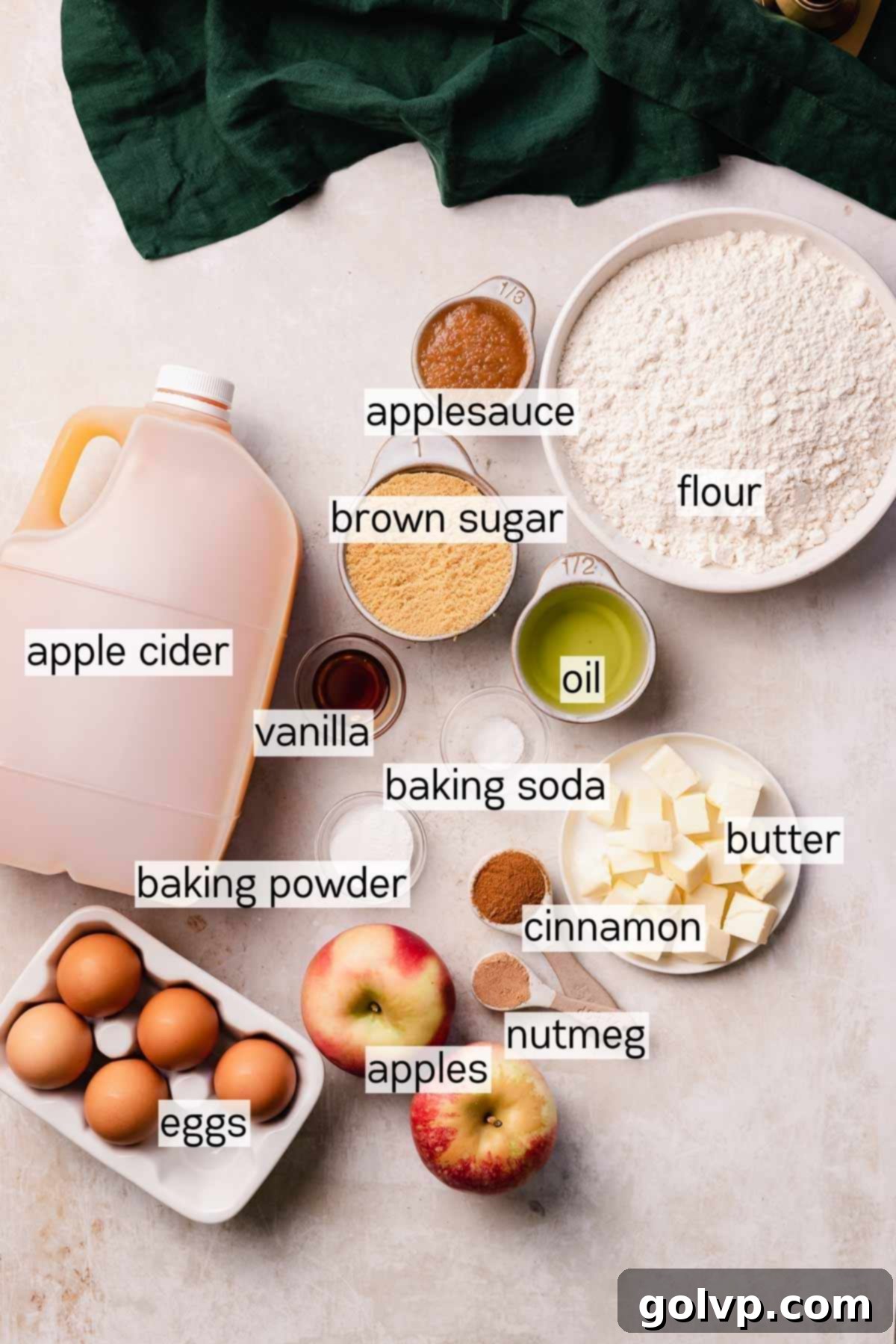
- Unsalted Butter: Opt for high-quality real butter to ensure the best flavor and texture in your cake. It’s crucial for the butter to be softened to room temperature for the cake batter, allowing it to cream smoothly with the sugars and create a light, airy base. Leave it out on your counter for about an hour before you plan to bake.
- Vegetable Oil: The addition of a mild-tasting oil, such as vegetable, light olive, grapeseed, or canola oil, is key to achieving an incredibly soft and moist cake crumb that remains tender for days. While butter provides richness and flavor, oil contributes to the cake’s longevity and delicate texture.
- Brown Sugar & Granulated Sugar: This recipe utilizes both brown and granulated sugars. Brown sugar is vital for its molasses content, which imparts a deeper, more complex flavor and contributes significantly to the cake’s moisture, creating a wonderfully gooey texture often seen in an apple cider donut cake. While you can substitute granulated sugar with brown sugar for an even richer flavor, avoid replacing brown sugar with granulated, as you’ll miss out on that essential depth and moistness.
- Large Eggs: Using room temperature eggs is important for proper emulsification. They incorporate more easily and evenly into the batter, leading to a smoother, lighter texture in the final cake. To quickly bring eggs to room temperature, place them in a bowl of warm water for five minutes, then pat them dry.
- Unsweetened Applesauce: Choose unsweetened applesauce to control the sweetness of your cake and allow the natural apple flavors to shine. If using homemade applesauce, ensure it has a thick consistency, similar to sour cream or hummus, to avoid making the batter too thin. Applesauce adds incredible moisture and a subtle apple tang.
- All-Purpose Flour: For accurate and consistent baking results, weighing your flour is highly recommended. If you don’t have a kitchen scale, use the “spoon and level” method: gently stir the flour in its bag, then spoon it into a measuring cup, scraping off any excess from the top with the flat edge of a knife, without packing it down. This prevents a dense or dry cake.
- Apple Cider: This is arguably the star ingredient for a truly flavorful apple cider bundt cake. You’ll find apple cider in the refrigerated section of most grocery stores. It’s distinct from apple juice, which is filtered and lacks the robust, tangy, and concentrated apple flavor that cider provides. Do not substitute apple juice unless absolutely necessary, as the flavor of your cake won’t be as prominent. **A critical note: apple cider is NOT apple cider vinegar!**
- Fresh Apples: For an extra layer of texture and bursts of fresh apple flavor, diced apples can be folded into the cake batter. This is optional; if you prefer a cake without chunks, simply omit them. Good choices include firm, slightly tart varieties like Honeycrisp, Granny Smith, or Fuji. If you find yourself with extra apples, consider making our delightful Caramel Apple Cheesecake Bars or the incredibly simple and delicious Sharlotka Apple Cake.
👩🍳 How to Make the Perfect Apple Cider Donut Bundt Cake
Apple Cider Bundt Cake Batter Step by Step
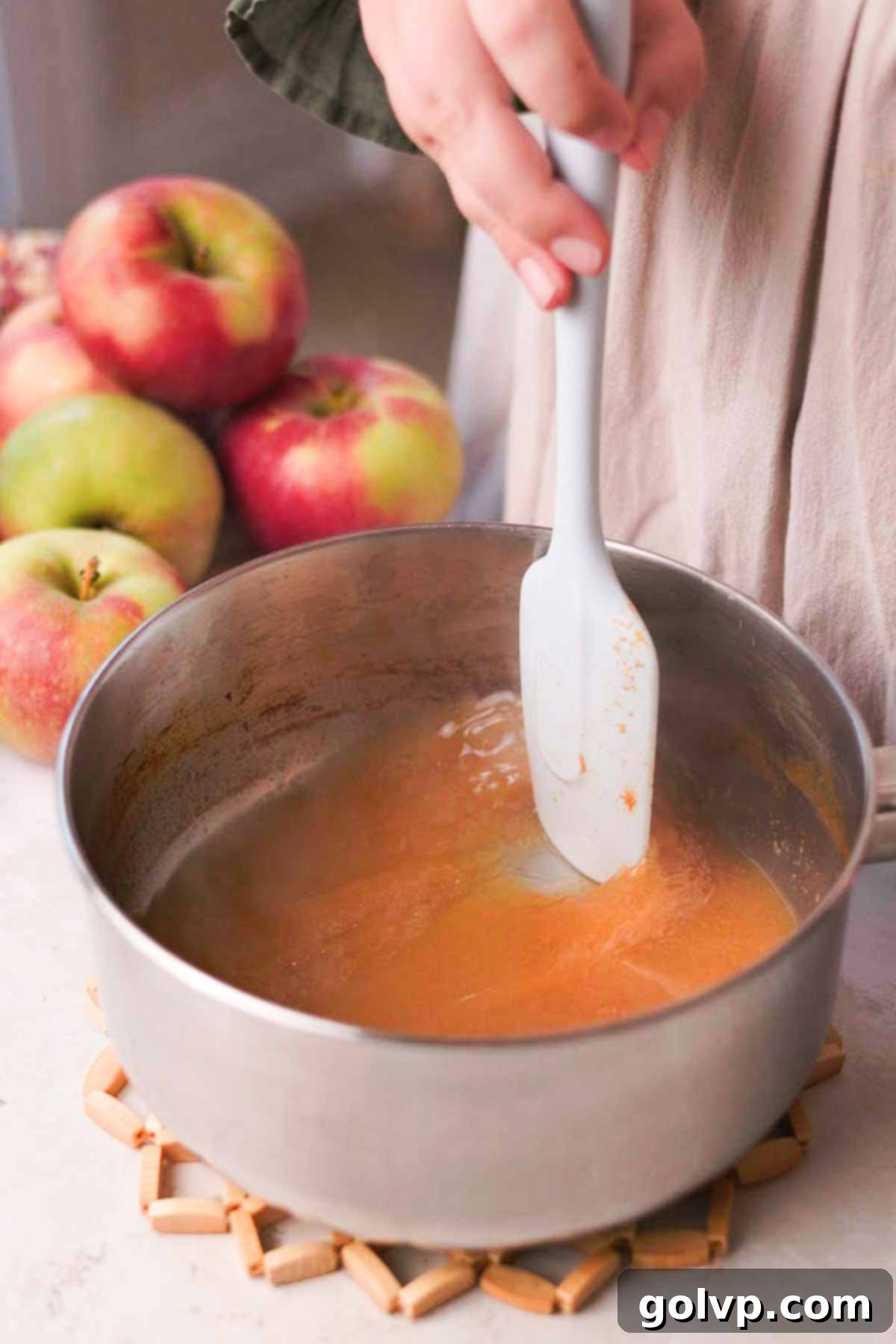
Step 1: Reduce the Apple Cider. Pour the apple cider into a medium saucepan. Bring it to a boil over medium heat, then reduce the heat to a simmer. Allow it to simmer gently, stirring occasionally to prevent it from sticking to the bottom, until it has reduced to approximately 1 ¼ cups. This crucial step concentrates the apple flavor significantly. You can proceed with preparing the other ingredients while the cider reduces. Once reduced, measure out ¾ cup of this concentrated apple cider and set it aside for later use in the batter.
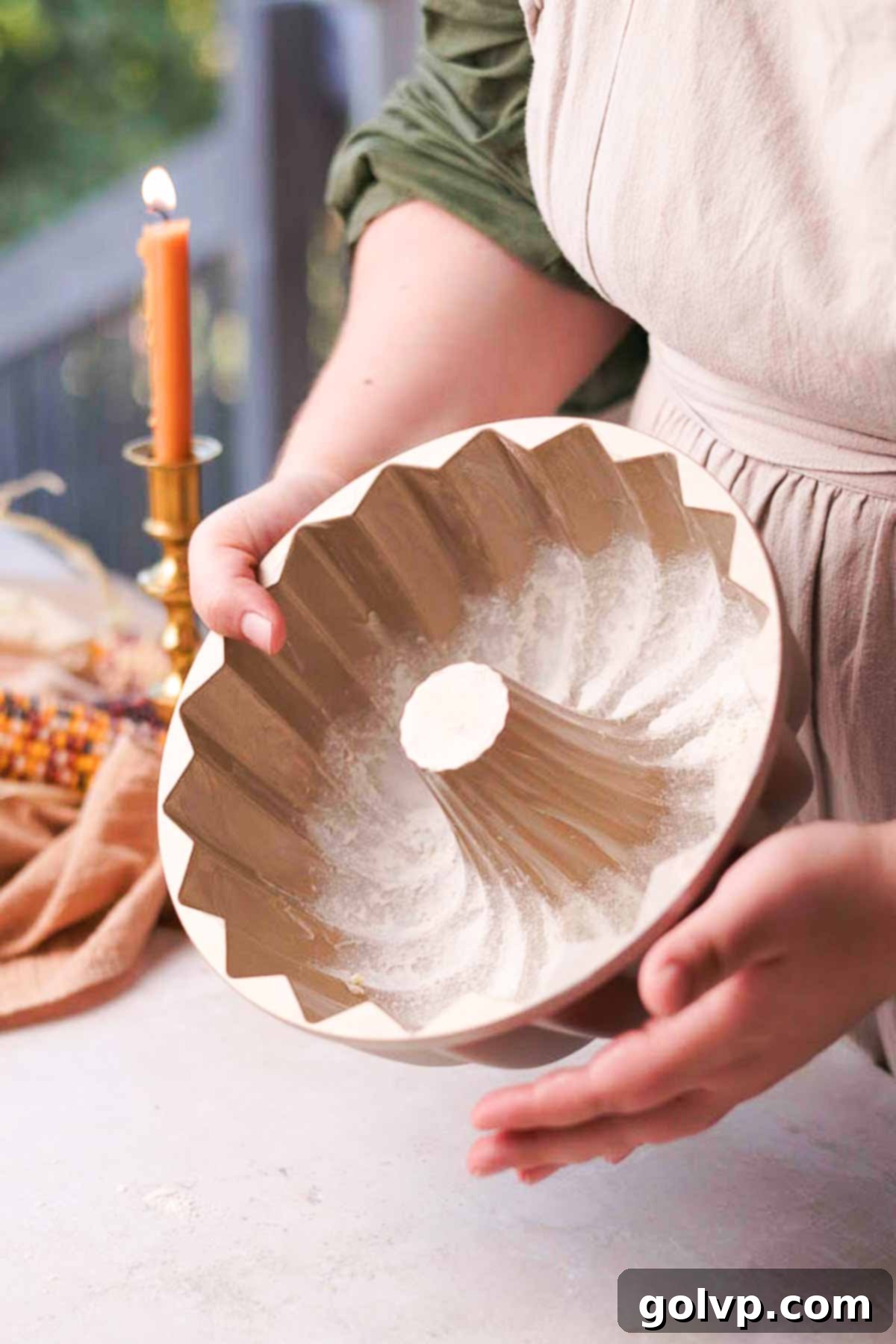
Step 2: Prepare the Bundt Pan & Preheat Oven. Preheat your oven to 355°F (180°C). To ensure your bundt cake releases perfectly, generously grease the inside of your bundt pan with a tablespoon of cold butter (or non-stick spray/oil). Once buttered, add a tablespoon of all-purpose flour and rotate the pan to evenly coat the entire surface. Tap out any excess flour. This creates a non-stick barrier, guaranteeing a beautiful, intact cake once baked.
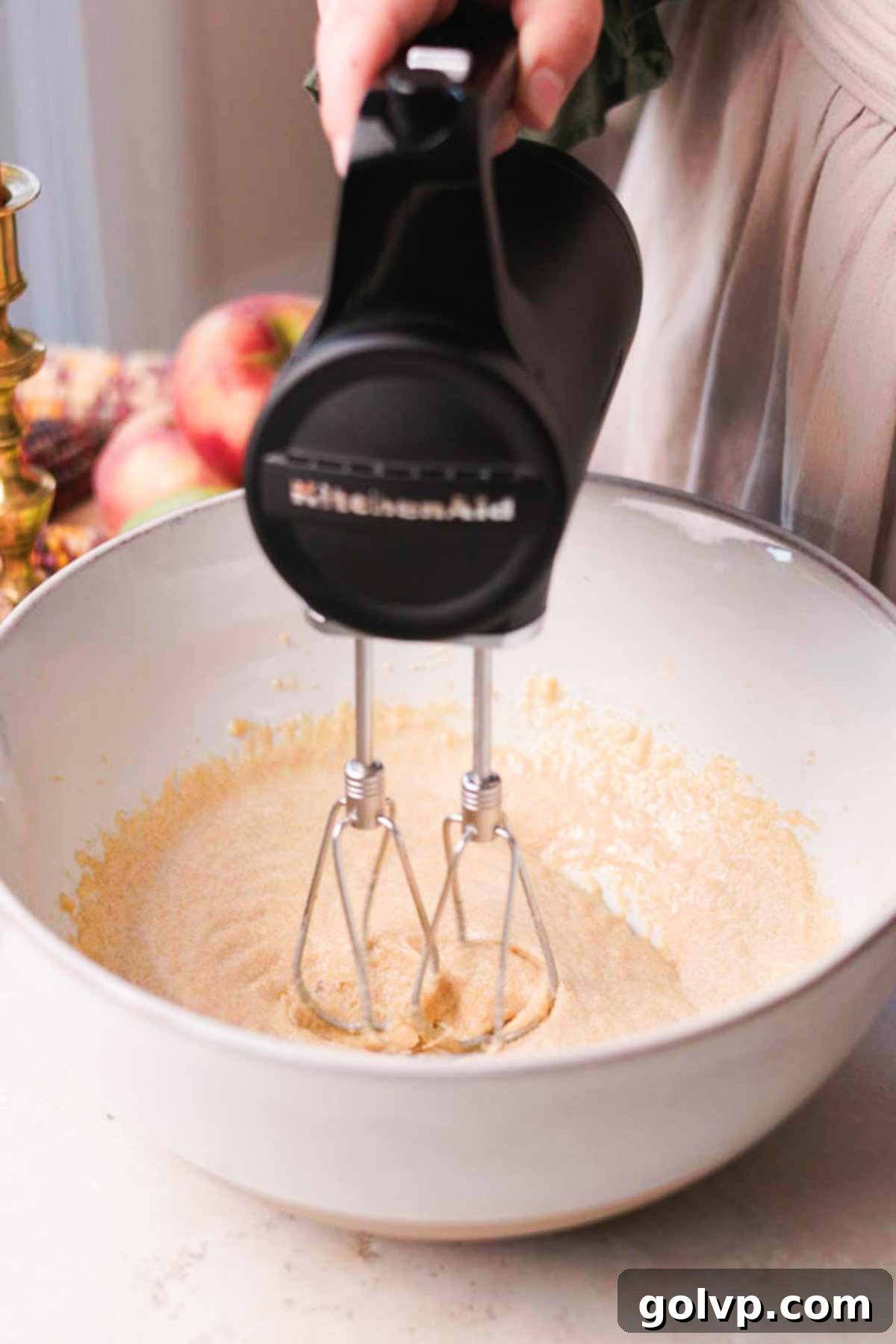
Step 3: Cream Butter, Oil, and Sugars. In a large mixing bowl or the bowl of a stand mixer fitted with the paddle attachment, combine the softened unsalted butter, vegetable oil, brown sugar, granulated sugar, and sea salt. Beat on medium-high speed until the mixture becomes light, fluffy, and pale in color. This creaming process incorporates air into the butter and sugar, which is crucial for a tender and well-risen cake.
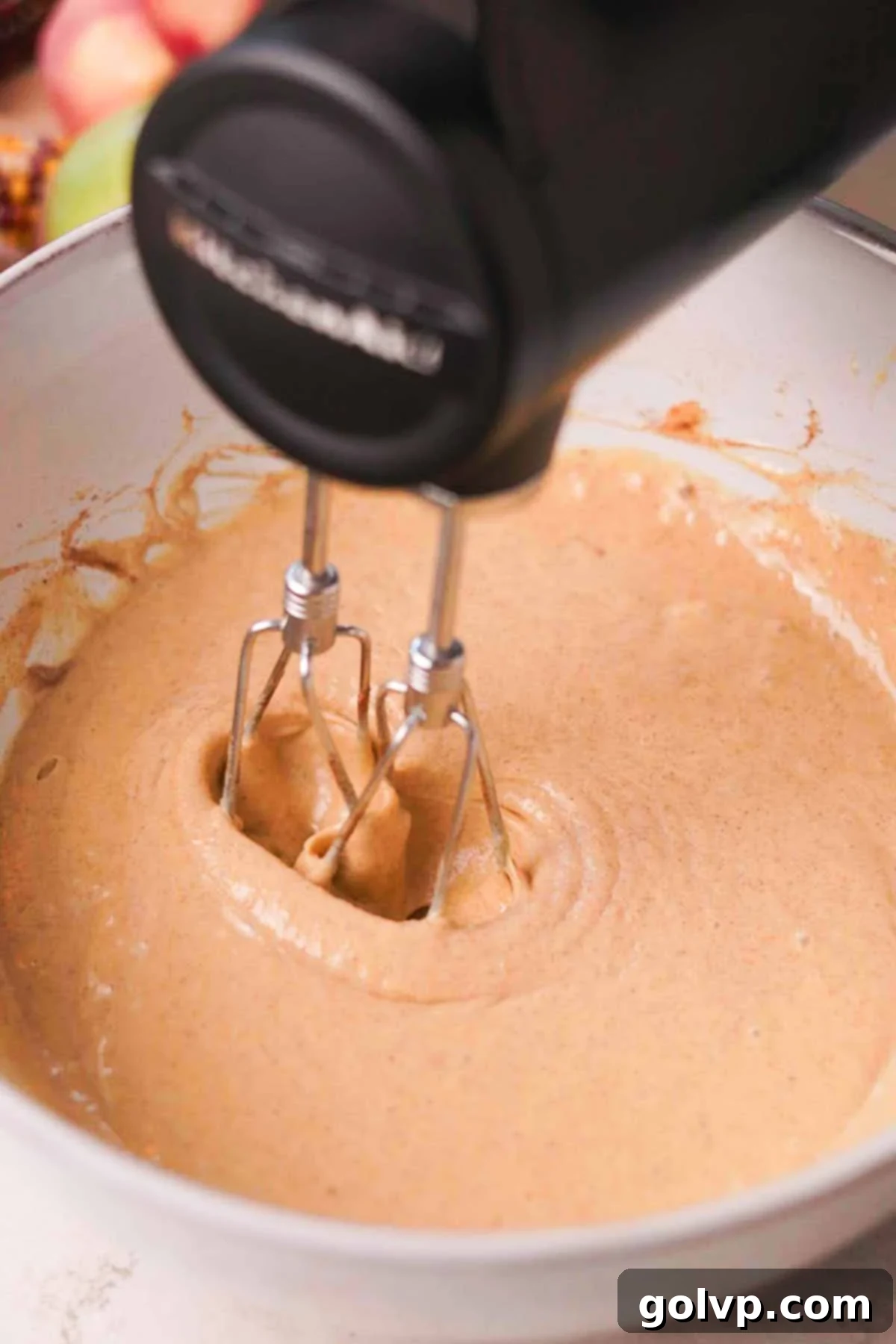
Step 4: Incorporate Wet Ingredients. Add the pure vanilla extract, then gradually add the room temperature large eggs, one at a time, beating well after each addition until fully incorporated. Scrape down the sides of the bowl as needed. Next, mix in the applesauce, ground cinnamon, and ground nutmeg. Continue to beat until everything is just combined. Don’t worry if the mixture appears slightly lumpy at this stage; it’s perfectly normal.
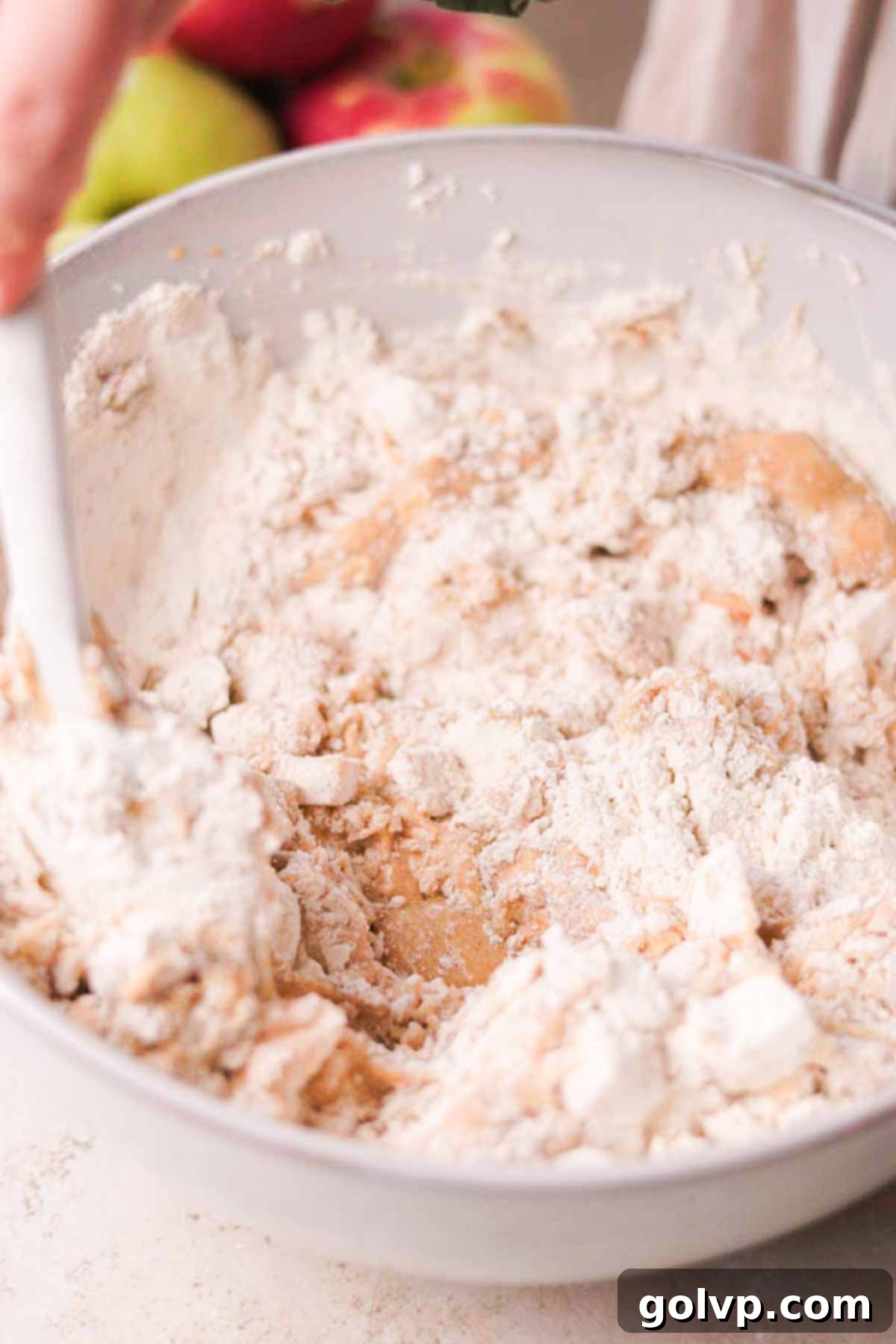
Step 5: Fold in Dry Ingredients and Apples. Sift the all-purpose flour, baking soda, and baking powder directly into the wet batter mixture. Add the diced fresh apples on top of the flour. Using a spatula, gently fold the dry ingredients into the wet until just combined, ensuring no dry streaks of flour remain. Be careful not to overmix, as this can lead to a tough, dry cake.

Step 6: Add Reduced Apple Cider. Pour the reserved ¾ cup of reduced apple cider into the batter halfway through the folding process. Continue to gently fold until the cider is just incorporated. Again, a slightly lumpy batter is fine; the key is to avoid overmixing, which develops gluten and can make the cake dense.
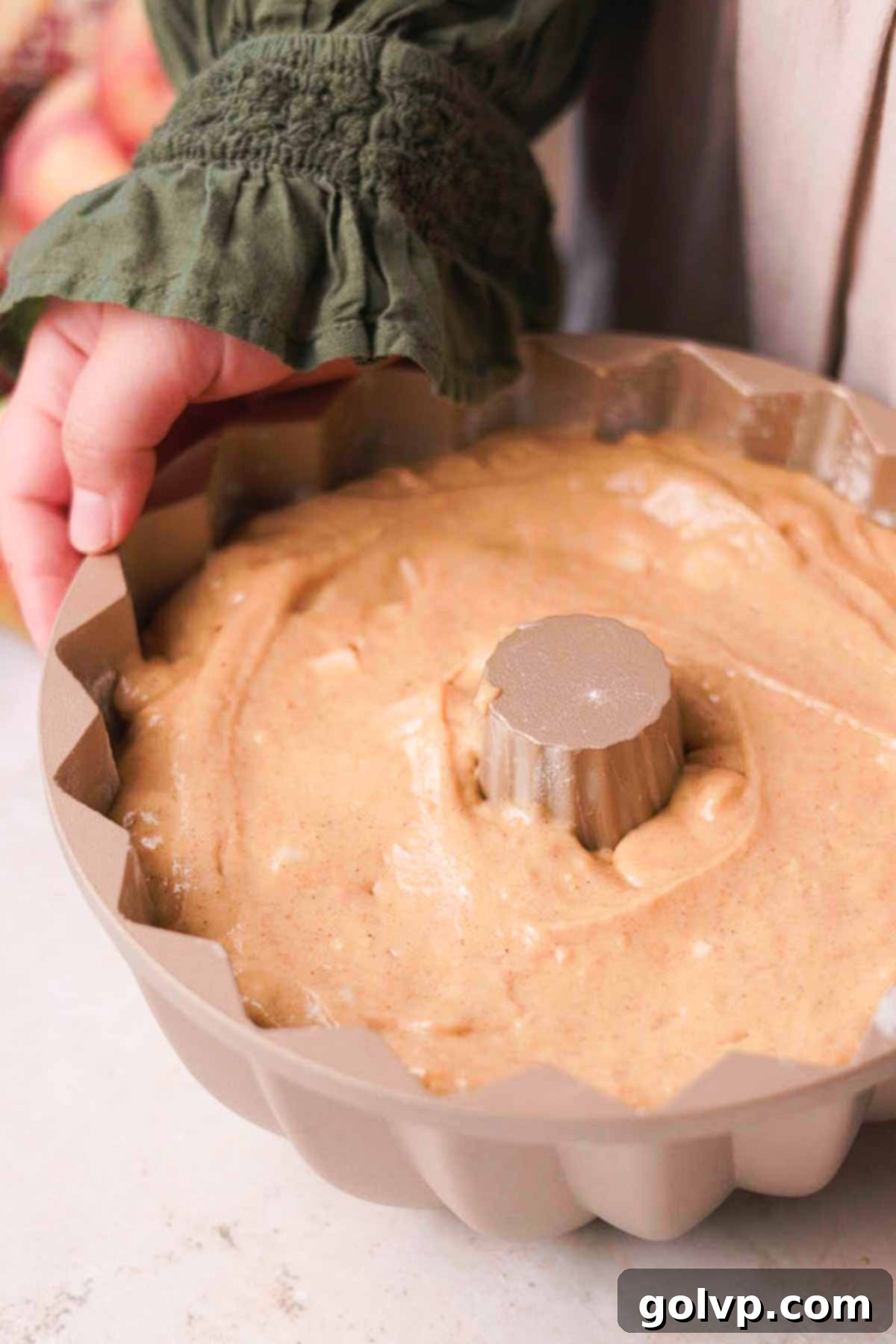
Step 7: Bake the Cake. Scoop the prepared batter into your generously greased and floured bundt pan, spreading the top evenly. Place the pan in the preheated oven and bake for 50-55 minutes. To check for doneness, insert a wooden skewer or toothpick into the center of the cake; it should come out clean, with no wet batter attached.
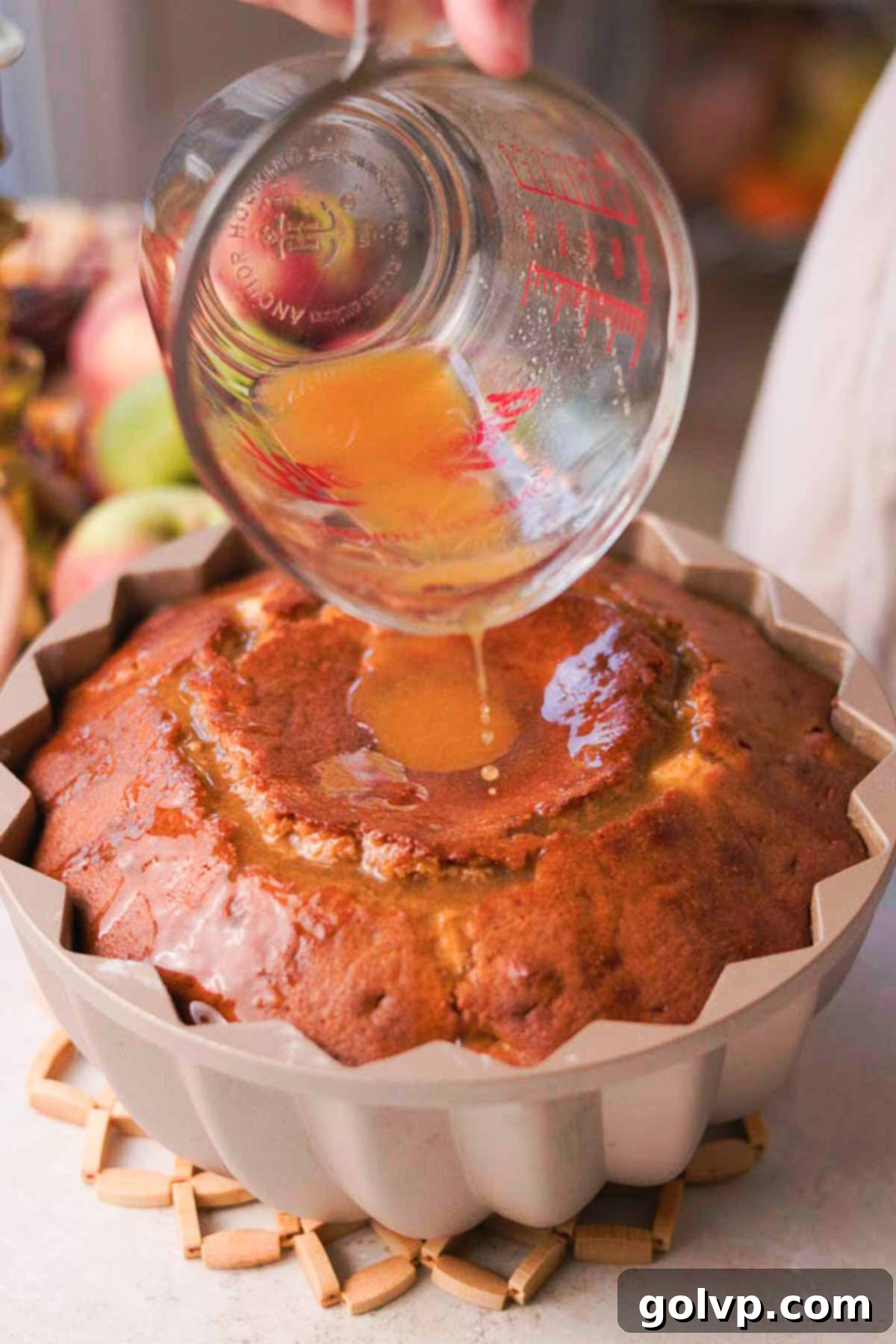
Step 8: Soak with Cider Syrup & Unmold. As soon as the apple cider donut bundt cake is removed from the oven, immediately and carefully pour the remaining ½ cup of reduced apple cider evenly over the top of the hot cake. It will absorb into the warm cake, keeping it incredibly moist. Allow the cake to cool in the bundt pan for exactly 10 minutes. Then, place a cooling rack or serving plate over the pan and, in one swift motion, flip the cake over. Give the bundt pan a few gentle taps to help release the cake before carefully lifting the pan away. Prepare the delicious brown butter topping while the cake continues to cool.
Topping Step by Step for a Perfect Finish

Step 1: Make the Brown Butter. (Optional: For a quicker method, simply use regular melted butter). Place the unsalted butter in a small, light-colored saucepan over medium-low heat. As it melts, stir constantly. The butter will begin to froth. Continue stirring as the foam gradually subsides, and the milk solids at the bottom of the pan start to caramelize, turning a beautiful golden-brown color and releasing a distinct nutty aroma. This process usually takes a few minutes, so watch it closely to prevent burning. Once achieved, remove from heat and let it cool slightly.
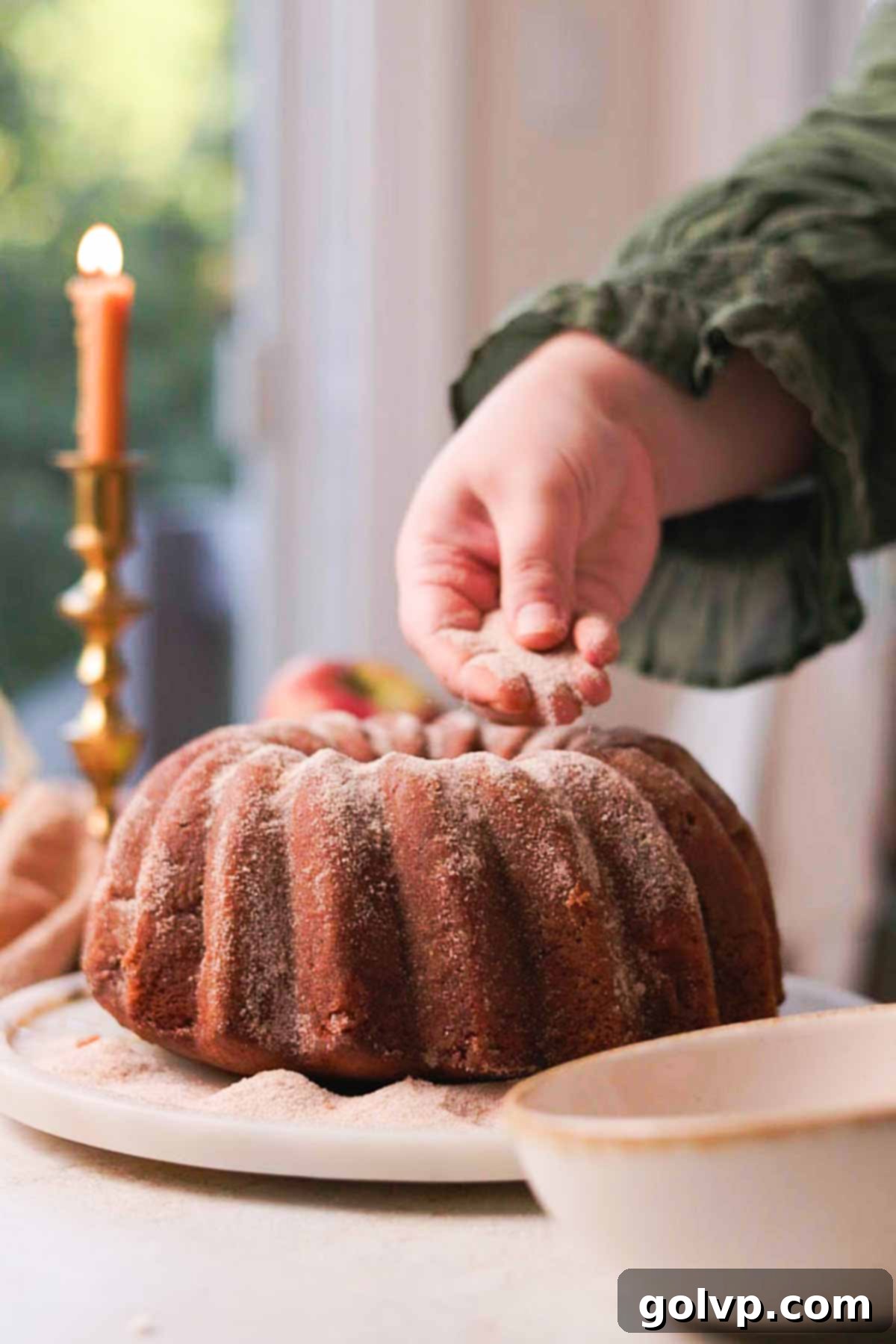
Step 2: Apply Cinnamon Sugar Topping. While the brown butter cools slightly, combine the granulated sugar and ground cinnamon in a small bowl. Liberally brush the unmolded bundt cake with the warm brown butter. Then, take handfuls of the cinnamon sugar mixture and gently press it all over the surface of the cake. This step can get a little messy, so doing it over a sink or a large tray is recommended. Once coated, your delicious apple cider donut bundt cake is ready to be sliced and served!
✔️ Expert Tips for Apple Cider Bundt Cake Success
- Always Reduce the Apple Cider: This step is non-negotiable for achieving a robust apple cider flavor. Skipping the reduction will result in a cake with a much milder, almost undetectable apple cider taste. Reducing it concentrates the natural sugars and tangy notes, making the flavor truly “pop” in your bundt cake.
- Do Not Overmix the Batter: Once you add the flour, fold the batter gently with a spatula only until no dry streaks of flour are visible. Overmixing develops gluten, leading to a tough, dry, and gummy cake texture rather than the desired tender, moist crumb.
- Generously Grease and Flour the Bundt Pan: This is a critical step for a smooth, clean release. Coating the entire inside of the bundt pan liberally with cold butter or cooking spray, followed by a thorough dusting of flour, ensures that your beautiful cake doesn’t stick and comes out perfectly intact.
- Pour the Apple Cider Syrup Immediately After Baking: The moment your cake comes out of the oven, while it’s still hot, gently pour the reserved reduced apple cider over its surface. The warmth of the cake allows it to absorb the syrup effectively, infusing it with extra moisture and flavor without making it soggy. If the cake cools too much before adding the syrup, it won’t absorb properly, potentially leading to a less moist texture.
- Adhere to the 10-Minute Cooling Rule: After baking, allow the bundt cake to cool in its pan for precisely 10 minutes before attempting to unmold it. Flipping it too early can cause the warm, delicate cake to deflate or break apart. Waiting too long, however, can cause the cake to stick firmly to the pan, making it difficult to release. This 10-minute window is the sweet spot for a perfect unmolding.
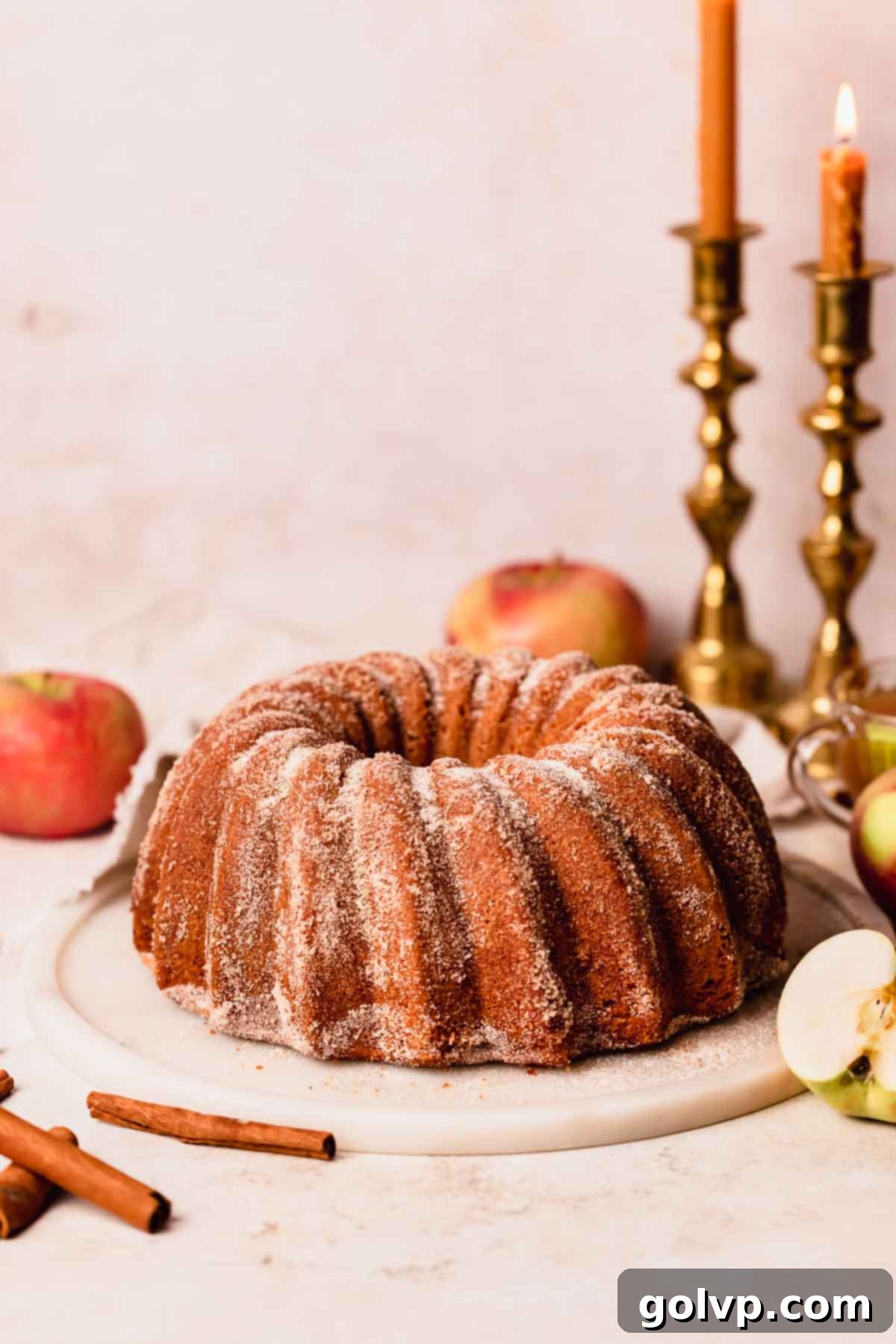
🥄 Make Ahead and Storage
This Apple Cider Bundt Cake is excellent for making ahead, and its moisture content helps it stay fresh. Store the cake in an airtight container at room temperature for up to 2-3 days, or refrigerate it for up to 5 days. For longer storage, you can freeze individual slices or the entire cake in an airtight container or wrapped tightly in plastic wrap and then foil for up to 2 months. Thaw frozen cake overnight in the refrigerator or at room temperature. For the best taste and texture, gently warm slices in the microwave or oven before serving to restore their delightful softness.
The apple cider reduction (syrup) can be prepared several days in advance and stored in a clean, airtight jar or container in the refrigerator. This makes the baking day even quicker and more enjoyable!
❔ How is this cake the perfect texture?
Achieving the perfect moist, tender, and fluffy texture in a bundt cake is a delicate balance, and this recipe masters it with a few key elements. While I adore the rich flavor that butter brings to any cake, extensive recipe testing has shown that combining butter with a small amount of oil yields the most superior texture. Butter contributes unparalleled richness and depth of flavor, making the cake taste truly decadent. However, the addition of a neutral-tasting oil ensures that the cake remains incredibly moist and soft for days, preventing it from drying out quickly. This dynamic duo creates a consistently moist and fluffy crumb every single time.
Furthermore, the inclusion of applesauce and the concentrated apple cider plays a significant role in both moisture and flavor. Applesauce provides natural fruit moisture and a lovely, subtle tang, while the reduced apple cider intensifies the apple essence and adds another layer of liquid that keeps the cake delightfully damp without being heavy. The synergy of these ingredients results in a bundt cake that is not only bursting with flavor but also boasts an absolutely irresistible texture.
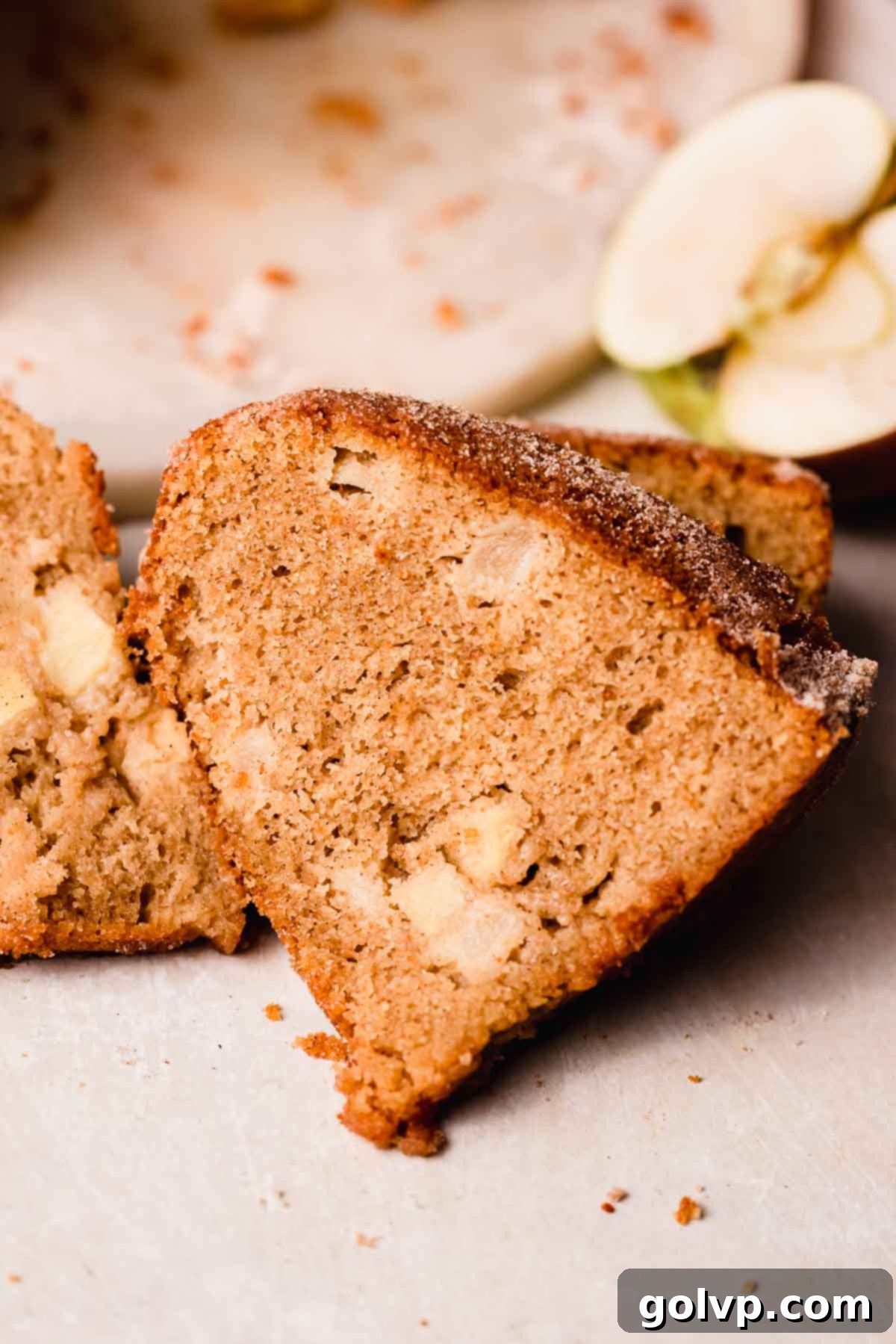
🍏 Apple Cider VS Apple Juice
IMPORTANT: Apple cider is NOT apple cider vinegar! Do not confuse them.
It’s crucial to understand the distinction between apple cider and apple juice for this recipe. While both are derived from apples, they are processed differently, resulting in vastly different flavor profiles. Apple cider, often found in the refrigerated section of grocery stores, is essentially raw, unfiltered apple juice. It undergoes minimal processing, which allows it to retain more of the apple’s natural sediments, pulp, and vibrant, tart flavor. This gives it a robust, cloudy appearance and a complex taste that is much stronger and tangier than its counterpart.
Apple juice, on the other hand, is filtered to remove pulp and sediment, then pasteurized to extend its shelf life. This process results in a clearer, sweeter, and significantly milder flavor. For our Apple Cider Bundt Cake, that intense, tangy “apple-y” punch from real apple cider is absolutely essential. Substituting apple cider with apple juice will result in a cake that lacks the distinctive, deep apple flavor that makes this recipe so special. Only use apple juice if you are truly in a pinch and understand that the final flavor will be considerably less pronounced.
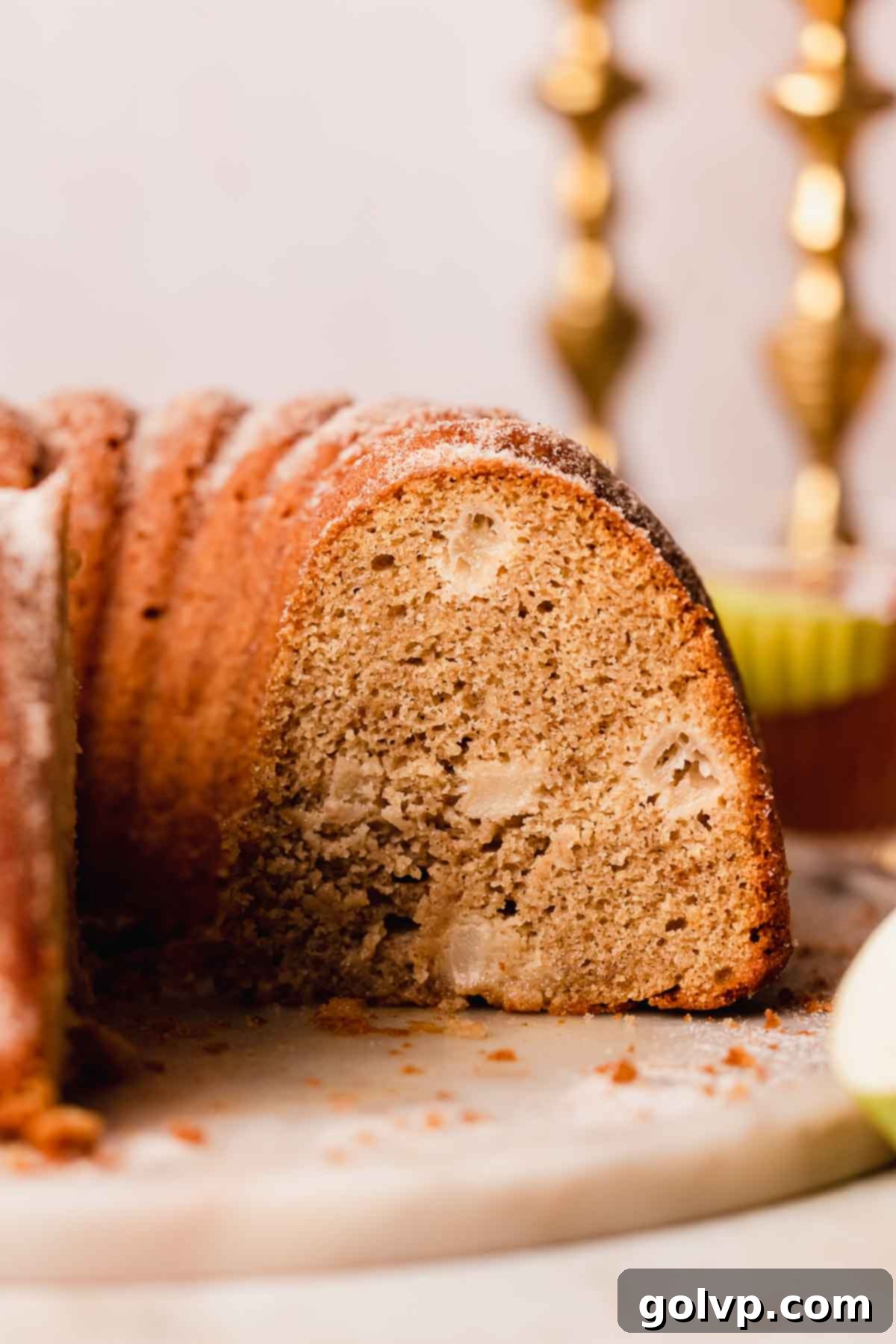
📖 Recipe FAQs
Brushing the cake with brown butter serves two fantastic purposes. First, the warm, nutty brown butter acts as a delicious adhesive, ensuring that the generous cinnamon sugar topping adheres beautifully to the cake. Second, brown butter itself adds an incredible depth of flavor – a toasted, caramelized, and slightly nutty note that complements the apple and spice flavors perfectly. If you’re short on time, you can certainly use regular melted butter, which will still help the sugar stick, but the brown butter truly enhances the overall taste profile.
Several factors contribute to a light and fluffy bundt cake. Firstly, accurate flour measurement is key: always weigh your flour for the most precise results. If using measuring cups, stir the flour, then spoon it gently into the cup and level it off without packing. Secondly, ensure all your cold ingredients, especially butter and eggs, are at room temperature. This allows them to emulsify properly and create a smoother, more aerated batter. Finally, the creaming process of butter, oil, and sugars needs to be thorough – beat until the mixture is truly light and fluffy, incorporating ample air, which is essential for the cake’s rise and tender crumb.
A perfectly unmolded bundt cake requires careful preparation and timing. Begin by thoroughly buttering or greasing your bundt pan, ensuring every crevice is covered. Then, add a tablespoon of flour and rotate the pan to evenly coat the entire greased surface, tapping out any excess. This creates a non-stick barrier. After baking, allow the cake to cool in the pan for exactly 10 minutes. Place a cooling rack or serving plate over the bundt pan, and with a confident motion, invert the cake. Give the pan a couple of firm taps on the counter to encourage the cake to release cleanly onto the rack. Using a good quality nonstick bundt pan that isn’t too worn will also significantly aid in a smooth release.
The ideal cooling time for a bundt cake in its pan is between 10 to 20 minutes, with 10 minutes often being the sweet spot for this particular recipe. You want to unmold the cake while it is still warm, but not so hot that it’s fragile and prone to breaking. This window allows the cake to firm up slightly, making it strong enough to handle the inversion without sticking or falling apart. Releasing it too early can cause it to collapse, while waiting too long can make it adhere to the pan as it cools and contracts.
🍂 More Related Recipes for Your Fall Baking Needs
If you loved this Apple Cider Bundt Cake, you’re sure to enjoy these other delightful recipes that are perfect for autumn and beyond!
- Cinnamon Bundt Cake with Gooey Cinnamon Swirl
- Sharlotka Apple Cake
- Chai Cake with Spiced Apple Filling
- Red Velvet Bundt Cake with Cream Cheese Swirl
Did you make this recipe? We would love for you to rate it and share your thoughts in the comments below! Share your delicious creation on Instagram and tag @flouringkitchen. Follow us on Pinterestto save and discover more wonderful recipe ideas.
📖 Recipe

Apple Cider Bundt Cake
Mary
Pin Recipe
Shop Ingredients
Equipment
-
Standard non-stick bundt pan (12 cups)
Ingredients
Cake
- 3 cups apple cider
- ½ cup unsalted butter softened
- ½ cup vegetable oil
- 1 cup brown sugar packed
- ¼ teaspoon sea salt
- 2 teaspoons pure vanilla extract
- 5 large eggs room temperature
- ⅓ cup applesauce room temperature
- ½ teaspoon nutmeg ground
- 1 tablespoon cinnamon ground
- 3 ½ cups all purpose flour 420g
- 2 ½ teaspoons baking powder
- ¼ teaspoon baking soda
- 2 large apples peeled and diced
Topping
- ⅓ cup unsalted butter
- ½ cup granulated sugar
- 2 teaspoons cinnamon ground
Shop Ingredients on Jupiter
Instructions
Cake
-
Pour 3 cups of apple cider into a medium saucepan. Heat over medium heat until it comes to a boil, then reduce the heat to a gentle simmer. Allow it to simmer until the volume has reduced to approximately 1 ¼ cups, stirring occasionally to prevent it from scorching. You can simultaneously prepare the other ingredients for the cake batter during this reduction process. Once reduced, measure out ¾ cup of this concentrated apple cider and set it aside to cool slightly.3 cups apple cider
-
Preheat your oven to 355°F (180°C). Prepare your bundt pan by generously greasing the entire interior surface with a tablespoon of cold butter (or oil). Then, sprinkle a tablespoon of all-purpose flour into the pan and rotate it, tapping gently, to evenly coat all the nooks and crannies. Shake out any excess flour. This meticulous preparation is essential to prevent the bundt cake from sticking and ensures a smooth release.
-
In a large mixing bowl, or using a stand mixer fitted with the paddle attachment, combine the softened unsalted butter, vegetable oil, packed brown sugar, granulated sugar, and sea salt. Beat on medium-high speed for 3-5 minutes, scraping down the sides of the bowl as needed, until the mixture is light in color and notably fluffy. This step is crucial for incorporating air and creating a tender crumb.½ cup unsalted butter, ½ cup vegetable oil, 1 cup brown sugar, ¼ teaspoon sea salt
-
Add the pure vanilla extract. Then, incorporate the room temperature eggs one at a time, beating well after each addition until fully blended into the mixture. Follow with the room temperature applesauce, ground cinnamon, and ground nutmeg. Continue to beat on low speed just until all these wet ingredients are combined. A slightly lumpy appearance at this point is perfectly acceptable.2 teaspoons pure vanilla extract, 5 large eggs, ⅓ cup applesauce, ½ teaspoon nutmeg, 1 tablespoon cinnamon
-
Sift the all-purpose flour, baking powder, and baking soda directly over the wet batter. Add the peeled and diced apples on top of the flour. Using a large rubber spatula, gently fold the dry ingredients into the wet mixture until just combined, being careful to stop as soon as no dry streaks of flour remain. Halfway through folding, pour in the ¾ cup of reduced apple cider (it’s fine if it’s still warm). Continue folding until just incorporated. Avoid overmixing, as this can lead to a dense and tough cake.3 ½ cups all purpose flour, 2 ½ teaspoons baking powder, ¼ teaspoon baking soda, 2 large apples
-
Carefully scoop the prepared bundt cake batter into your greased and floured bundt pan. Use the back of the spatula to gently spread the top of the batter smooth and ensure it’s evenly distributed in the pan.
-
Bake the bundt cake in the preheated oven for 50-55 minutes. To verify doneness, insert a wooden skewer or toothpick into the deepest part of the cake. It should come out clean or with only a few moist crumbs attached. If it comes out with wet batter, continue baking for a few more minutes and test again.
-
Once baked, immediately remove the bundt cake from the oven. Carefully and slowly pour the remaining ½ cup of reduced apple cider evenly over the entire surface of the hot cake while it is still in the pan. The warm cake will readily absorb this concentrated syrup, infusing it with extra moisture and intensifying the apple flavor.
-
Allow the cake to cool in the bundt pan for precisely 10 minutes. This crucial cooling time allows the cake to firm up slightly, preventing it from deflating or breaking when unmolded. After 10 minutes, place a wire cooling rack or a sturdy serving plate over the bundt pan, and with a swift, confident motion, invert the cake. Give the bottom of the bundt pan a few gentle taps to help release the cake before carefully lifting the pan away. While the cake continues to cool, proceed to prepare the delicious brown butter topping.
Topping
-
(For a quicker alternative, you may simply use regular melted butter instead of browning it.) To make the brown butter, place the ⅓ cup of unsalted butter in a small, light-colored saucepan over medium-low heat. Stir constantly as the butter melts, then continues to cook. It will begin to froth vigorously. Keep stirring and watching closely. The foam will eventually subside, and tiny milk solids at the bottom of the pan will start to turn golden brown and then a rich amber color, emitting a wonderfully nutty aroma. Remove it from the heat immediately once this occurs to prevent burning. Allow the brown butter to cool slightly before use.⅓ cup unsalted butter
-
While the brown butter is cooling to a warm temperature, prepare the cinnamon sugar mixture. In a small bowl, thoroughly mix together the ½ cup of granulated sugar and 2 teaspoons of ground cinnamon until well combined.½ cup granulated sugar, 2 teaspoons cinnamon
-
Liberally brush the entire surface of the cooled bundt cake with the warm brown butter. Once coated, take handfuls of the cinnamon sugar mixture and gently press it all around the cake, ensuring an even and generous coating. This can be a bit messy, so it’s best done over a sink or a large tray to catch any excess. Once fully coated, your spectacular apple cider donut bundt cake is ready to be sliced and served immediately!
Notes
Make Ahead: The concentrated apple cider reduction/syrup is perfect for preparing in advance. You can make it up to a few days ahead of time and store it in a sealed jar or container in your fridge. This small step can significantly streamline your baking process on the day you plan to make the cake.
Key Tips for Unparalleled Success:
- For the most intense and authentic apple flavor, it is absolutely essential to reduce the apple cider as instructed. This concentrates the natural sugars and tangy notes.
- To ensure a tender and moist cake, avoid overmixing the batter once the flour is added. Stop folding as soon as no dry streaks of flour are visible to prevent gluten development.
- Guarantee a perfect, clean release from your bundt pan by generously buttering and flouring every inch of its interior before adding the batter.
- Pour the apple cider syrup over the hot cake immediately after it comes out of the oven. This allows the cake to fully absorb the syrup, resulting in a supremely moist (not soggy) crumb.
- Respect the 10-minute cooling period in the pan before flipping the bundt cake. This crucial window prevents the cake from deflating if unmolded too early and from sticking if left too long.
